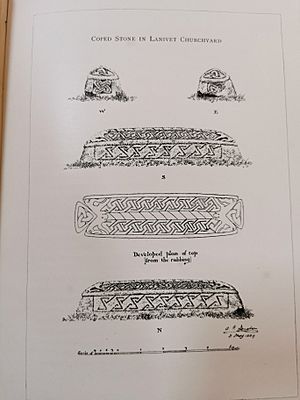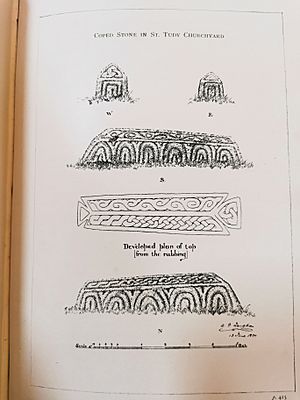Hogback (sculpture) facts for kids

Hogbacks are special stone carvings from a long time ago, between the 10th and 12th centuries. They were made by people with both Anglo-Saxon and Scandinavian backgrounds. You can find them mostly in England and Scotland. A few have also been found in Ireland and Wales.
These unique stones were used as grave markers. They look a bit like a house or a chest. By the early 11th century, people stopped making them. Similar grave markers have been found in Scandinavian countries. In Cornwall, these kinds of stones are called coped stones.
Contents
What Do Hogbacks Look Like?
Hogbacks are usually long, low stone monuments. They often have a curved top, like a hog's back, which is how they got their name! Their sides might also curve outwards.
Many hogbacks are decorated with patterns that look like shingles. This makes them seem like little houses for the dead. This "house" shape might be like the old Scandinavian longhouse. These halls were important in the pre-Christian Norse religion, where people imagined feasting in places like Valhalla.
Where Are Hogbacks Found?
It's thought that hogbacks were first made around the year 920. Many of them are found in Yorkshire and Cumbria in England. There's also a big group in Govan, near the River Clyde in Scotland. These areas are probably where the hogbacks first appeared.
You can find single hogbacks in many other places too. They stretch from Derbyshire in England all the way to Central Scotland. Hogbacks in Scotland likely spread along the Forth-Clyde route, which connected York, England, to Dublin. Most Scottish hogbacks are found near old sea routes.
There's one hogback in Ireland at Castledermot, which looks like two stones in Ingleby Arncliffe, England. Wales also has one at Llanddewi Aberarth Church.
Famous Hogback Collections
The largest collection of hogbacks is kept at St Thomas's church in Brompton, North Yorkshire. These were found in 1867. Six of them were moved to Durham Cathedral Library. Four whole ones and some broken pieces stayed at Brompton. These hogbacks are special because they have carvings of bears. The bears look like they are hugging the stones with straps in their mouths.
Another important collection is at Govan Old. Five impressive hogbacks are now in the Govan Stones museum in Govan, Glasgow. You can also see a beautiful hogback at the visitor centre on Inchcolm island. There's also a very well-decorated one at St Peter's Church, Heysham.
Types of Hogbacks
There are two main types of hogbacks.
- Brompton type: These hogbacks have large, animal-like carvings at their ends.
- Warrior's tomb type: These look more like a house and do not have the big end-beasts.
Within these two main groups, there are smaller styles. For example, the "scroll type" hogback is a kind of warrior's tomb. It has scroll patterns carved on a band below the shingle-like roof.
Hogbacks at Govan
Govan is a place on the south bank of the Clyde River. It has the four largest known hogbacks. There are five hogbacks in total at Govan Parish Church.
The oldest Govan hogback is from the mid-10th century. It has two rows of shingle carvings with curved lines. Below the shingles, there's a band of interlace patterns. These patterns are not the same on both sides and are not continuous. This hogback is unique at Govan for its "stopped-plait interlacing" and "running ring-knot interlace."
The other four hogbacks at Govan are from the late 10th century.
- The longest one is covered in shingle rows, but they are not curved. It's wider and has a flatter roof.
- The third hogback is huge! It has a large, 3D animal carved at one end. This animal stretches across the whole stone.
- The fourth hogback also has a single animal at its end. Its head faces outwards, which is unusual. The animal's legs point towards its head. The roof looks like a spine, and the shingles are like scales.
- The fifth hogback has two animals, one at each end. Their faces and bodies are shown from the side, with their mouths open. Their legs cross each other at the bottom. This is the only hogback known with animals in this position.
Coped Stones in Cornwall
In Cornwall, grave markers similar to hogbacks are called coped stones. There are five known coped stones still existing. They are found in St Buryan, Lanivet, Phillack, St Tudy, and one was found in Padstow in 2012.
Cornish coped stones are usually longer than typical hogbacks, often over 2 meters long. However, they are not as tall. They also have a unique hipped roof style. The Lanivet stone is the only one in Cornwall that has animals carved on its ends. These stones show a mix of Scandinavian and local Cornish art styles. This suggests that Cornwall was part of a "western British Viking-age sculptural tradition."
See also
- Anglo-Saxon art#Monumental sculpture and wall painting
- The Botkyrka monument
- Eskilstuna cist
- Lily stone
- Västergötland Runic Inscription 81




